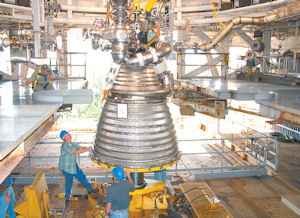Pratt & Whitney Rocketdyne, a fixture in the San Fernando Valley for more than 50 years and a trailblazer in space exploration, now is facing the unknown head-on as its parent company officially placed the rocket engine maker on the selling block. Hartford, Conn.-based United Technologies Corp., recently announced plans to sell the Canoga Park division, as well as its Clipper Windpower and the Hamilton Sundstrand Industrial divisions, to finance its $16.5 billion acquisition of aerospace supplier Goodrich Corp. The announcement on March 15, while not a complete shock to market observers, raises serious questions about whether Rocketdyne will continue to call the Valley — where it employs more than 1,500 employees — its home. Rocketdyne’s 47-acre Canoga plant was the center of activity for the U.S. space program in the 1960s, when its predominantly male workforce used slide rules and hand calculations to design the F-1 and J-2 engines that lifted the Saturn V rocket to the moon. The campus reached an employment peak of nearly 20,000 in the late 1960s. The end of the Apollo program saw a dramatic decrease in manpower and those that remained were to put to work on designing the engines for the Space Shuttle, which has kept the company busy until the program ended last July. In the call with the analysts on March 15, United Technologies CFO Gregory J. Hayes announced the sale plans, noting that without a national space policy, growth at Rocketdyne would be limited. United Technologies expects to get final bids for Rocketdyne in the next couple of weeks and close the deal before the end of the year, he said. “It’s been a good business, but as we sit here today, it is really not core to the UTC businesses of commercial and military aerospace and defense and commercial construction,” Hayes said. In an interview with the San Fernando Valley Business Journal, Pratt & Whitney Rocketdyne President Jim Maser said the news did not come as a surprise and he had already prepared his managers for the announcement. Following the announcement, he said he also began meeting with employees. He said several firms are interested in acquiring Rocketdyne, but declined to comment on potential suitors. Brian Langenberg, an analyst with Langenberg & Co. who follows United Technologies, declined to speculate on what companies would likely be interested in acquiring Rocketdyne. Alliant Techsystems Inc. (ATK), Boeing, and EADS all have space divisions. “Anybody in the space business who wants to bulk up during this trough will take a look,” Langenberg said. Future of Rocketdyne Maser said a sale would not impact the company’s business strategy and programs. One potential benefit of new ownership, he said, is having an owner that has better appreciation of Rocketdyne’s rocket engine propulsion business as a core business. “We are going to be core to what strategy they have,” he said. The company has gone through a series of ownership changes since its start. Rocketdyne started out as a division of North American Aviation. In 1967, North American Aviation merged with Rockwell Corporation, becoming North American Rockwell and then Rockwell International. In 1996, the merged company sold its aviation assets including Rocketdyne to Boeing. United Technologies’ Pratt & Whitney division bought Rocketdyne in 2005. Rocketdyne also has weathered irreversible changes in the aerospace industry — changes that have fundamentally impacted its operations. It has laid off more than 500 workers since January 2010 as the end of the shuttle program and NASA budget cutbacks forced the company to make cuts of its own. While Rocketdyne has stabilized, Maser said, it may still be necessary to make staff reductions at some level this year. He said the company often assesses it staffing levels and any future announcement would not be the result of being divested. Rocketdyne is supplying the engines for NASA’s Space Launch System, the first exploration-class vehicle from the space agency since the Saturn V. The company is contributing launch abort engines and orbital maneuvering and attitude thrusters for the Crew Space Transportation vehicle being built by Boeing Corp. as part of NASA’s Commercial Crew Development program. Additionally, the company has broadened its client base by getting into the alternative energy market. In October, Rocketdyne was contracted by SolarReserve to provide solar energy components and control technology for a 110-megawatt solar project in the Nevada desert. “We see opportunities, but to some degree they are dictated by events that are out of our control that are largely political,” Maser said. Business Journal Staff Reporter Andrew Khouri contributed to this story.
